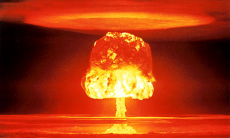
Email: ZYVC057@live.rhul.ac.uk
Total Article : 213
About Me:I'm a graduate student studying International Criminal Law and first started writing for King's News almost 4 years ago! My hobbies include reading, travelling and charity work. I cover many categories but my favourite articles to write are about mysteries of the ancient world, interesting places to visit, the Italian language and animals!

Close your eyes and imagine a weapon so powerful it could wipe out a population in a matter of seconds.. now open your eyes. These weapons exist, they are nuclear arms. After the tragic atomic bombings of Hiroshima and Nagasaki during World War Two, it became apparent that world politics had forever changed. The fact that nations had the power to exterminate lives so swiftly and destroy the enemy so easily was seen as a gift to some and a curse to others. During the years characterised by the Cold War states both the US and the Soviet Union rushed to build nuclear weapons in what is commonly known as the arms race. There came a point of stagnation in which both sides had enough nuclear power to cause serious damage but it was never used. The closest the two blocks came to a full scare nuclear war was during the Cuban missile crisis and, had the nuclear attack taken place, the world would have been silenced.
Today, nuclear proliferation, that is the spread of nuclear arms, is a central topic to war and security studies and many scholars have prioritised the question of a possible future nuclear war. From a realist perspective (realists are the scholars that view politics as a cynical struggle for power) the spread of nuclear arms can be explained as a hard security issue. States are pressured into building these weapons to maintain their own sovereignty (national independence) and power. According to realists, the US acquired nuclear weapons because they were threatened by Nazi Germany whereas the Soviet Union started their own stockpile due to the threat of the US. France began following suit as it didn’t trust the US to provide a nuclear umbrella of protection if any states were to target France and China did the same as it didn’t trust that the Soviet Union would protect it. This fits perfectly into classical realism as each states pursues what is in its own interest and is worried about its own power.
One group of scholars, known as the nuclear optimists, believe that the spread of nuclear weapons may be beneficial for all. As neo-realist Kenneth Waltz famously stated ‘more may be better’ as it leads to Mutual Assured Destruction (MAD). This is when two rivalry states have large stockpiles of nuclear weapons which means if one state destroys the enemy that enemy then has the same power to destroy them. If both states know the other can easily destroy them if they were to attack, then it is in the interest of both states that neither attacks. Kenneth Waltz goes on to say that the slow and steady proliferation of nuclear weapons would place all nations on the same playing field where none could openly attack without losing out themselves.
In contrast to this theory other academics, known as the proliferation pessimists, argue that the spread of these weapons will have a catastrophic event on societies worldwide. Their main exponent, liberal thinker Scott Sagan, has no faith in the MAD theory. Instead, he stresses that nobody could ever guarantee that nations wouldn’t use nuclear arms even at the cost of their own national security. Sagan also mentions that, contrary to the realist assumption, states may want to build these weapons for other reasons than just power gain. For example, it could be that a bureaucratic department or a single individual strongly pushes for the development of these issues instead of the government of that state. Other explanations can be the desire of prestige that can be gained by having such dangerous weapons or the idea that if the technology is out there then nations will be driven to use it. The main feature that optimists and pessimists of nuclear proliferation have in common is the framing of their question. They all tend to look at why states would want to use nuclear weapons to then predict if they actually would; the only issue is that it’s almost impossible for us to really know all the deep dark secrets which lie behind nuclear arms.
Image: http://static.guim.co.uk/sys-images/Technology/Pix/pictures/2009/7/24/1248433874260/Nuclear-Explosion-001.jpg

0 Comment:
Be the first one to comment on this article.